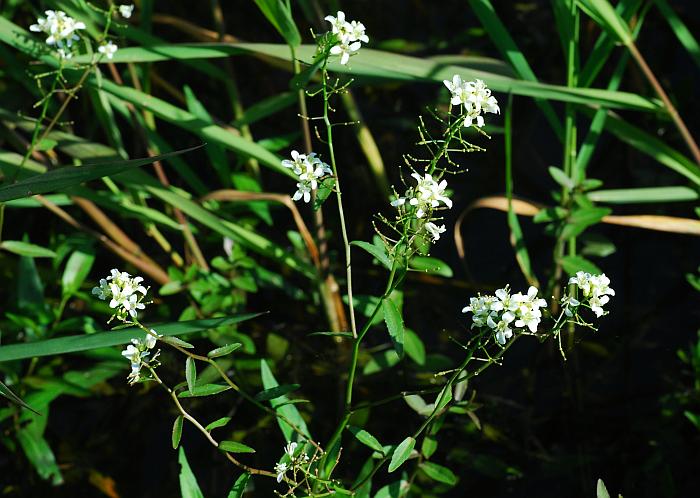Rorippa aquatica (Eaton) E.J. Palmer & Steyerm.
Lake Cress

Native
CC = 10
CW = -5
MOC = 11
SRank = S2
© SRTurner
Rorippa aquatica (Eaton) E.J. Palmer & Steyerm.Lake Cress | |
 |
Native CC = 10 CW = -5 MOC = 11 SRank = S2 |
© SRTurner |
|
Family - Brassicaceae Habit - Perennial herbs, lacking rhizomes. Stems - Spreading to erect, with bases often rooting at nodes, to 85 cm, usually unbranched below the inflorescence, glabrous.
Leaves - Alternate, to 7 cm, glabrous. Submerged or lowermost leaves irregularly pinnately dissected into numerous threadlike to linear segments. Upper leaves simple, entire or toothed, lanceolate.
Inflorescences - Terminal racemes or panicles.
Flowers - 4-merous in typical Brassicaceae pattern. Sepals 2-4 mm long, ascending, elliptic to obovate, glabrous. Petals 4-8 mm long, unlobed, white. Styles 2-4 mm long.
Fruits - Spreading, often aborting prior to maturity, 3.5-7.0 mm long, less than 2 times as long as wide, elliptic to narrowly obovate in outline, circular or slightly flattened in cross-section, the stalks 6-12 mm long. Seeds rarely present, 12-30 per fruit, in 2 rows in each locule, 0.7-1.4 mm long, ovoid to subglobose, the surface with a netlike or honeycomb-like pattern of ridges and pits, brownish orange
Flowering - May - August. Habitat - Swamps, sloughs, spring branches, ditches. Origin - Native to the U.S. Lookalikes - Cardamine bulbosa. Other info. - This species is uncommon in Missouri, and indeed has become uncommon across most of its range, which comprises sparse locations throughout much of the Midwest and Canada. Its white flowers are unusual, since other members of the Rorippa genus have yellow flowers. It is also unusual in that leaves which drop from the plants can root and develop into vegetative rosettes, perhaps compensating to some extent for the poor seed set. Nonconformities such as these have rendered taxonomic placement difficult, and the assignment remains controversial. Other authors have assigned these plants to the Armoracia or Neobeckia genera. Photographs taken at Duck Creek Conservation Area, Stoddard County, MO, 5-13-2016; and at Shaw Nature Reserve, Franklin County, MO, 6-27-2024 (SRTurner). |